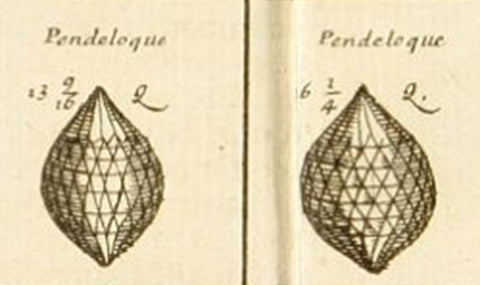
Briolette Cut
The Briolette cut is one of the most rare and dazzling cuts for a diamond. A drop shaped stone with facets abound, a briolette almost gives the perception of a distinguished disco ball dangling and shining in the light. Almost exclusively dedicated to large, clean diamonds, a briolette cut diamond emphasizes elegance on par with historical royalty. A perfect cut for important diamonds, a briolette cut shows off the entirety of a diamond, allowing the wearer and observer to fully appreciate the beauty of the stone.
Briolette cuts do not have tables, crowns, or pavilions, and as a result they cannot sit traditionally in a ring, nor can they be fashioned on a bracelet (unless you want it to dangle like a charm). Their girth and facets are varied, and to be fully enjoyed they must be hung to dangle upside down so that their swollen bellies can catch the light. In order to accomplish this, a miniscule hole is drilled at the top of the cut for a wire to pass through, enabling them to dangle elegantly on a pair of earrings, tiara or necklace.
The World’s First Briolette Cut Diamond
There is a lot of uncertainty around what technically qualifies as the worlds “first briolette cut diamond”. For a lot of people, the oldest diamond in recorded history, the Briolette of India, earns that title. The stone dates all the way back to the 12th century, but realistically, it was probably a large rough diamond for most of its history. When this famous stone came out of hiding in 1908, it was described as a “double rose cut” before it was cut into a more traditional briolette and turned into a pendant by Cartier.
For most historians, the first pure briolette cut diamond was produced by one of the most significant lapidaries in the history of stone cutting: Lodewyk van Bercken. Van Bercken was the “alleged” inventor of the scaif, which is still the same principle that diamond cutters use to facet diamonds and gemstones today. He is credited with creating the idea of smooth faceting, as well as the pear shape diamond, and perfecting the art of symmetry within a diamond with the world’s first briolette cut.
As we have discussed previously, realistically there is a very small change that he actually made all of these advancements, and there is a solid chance that he never existed at all. If he did make advancements in diamond cutting, they were most likely relatively small improvements and not the complete revolution of the industry with which his descendants, and eventually the rest of the world, gave him credit.
Based on the similarities between a Mughal/Mogal cut, and the fact that the first references of a briolette cut come from our friend Jean-Baptiste Tavernier who sold two briolette cut diamonds to King Louis XIV of France. He drew a diagram of the stones, and referenced them as an “Indian Pear” when describing the cut. All things considered, it’s pretty safe to say that the briolette was first cut in modern day India.
Famous Briolette Cut Diamonds
While many old briolette cut diamonds have since been recut into more modern shapes, there are still plenty of important stones out there which exhibit this mesmerizing effect. Besides the “Briolette of India” discussed earlier, some other famous briolette cut diamonds include the 116.60ct Light Fancy Yellow “Vainer Briolette Diamond”, an unnamed 180.85 ct Yellow diamond, another Vainer owned 101.25ct Fancy Yellow briolette cut diamond, the 95ct Fancy Yellow “Waska Diamond” set in a swan brooch by Van Cleef and Arpels in 1971, and the 75.36ct Type IIa briolette cut “Star of China”.
While not a single briolette cut diamond, the “Napoleon Diamond Necklace” is one of the most magnificent examples of surviving briolette cut diamond jewelry. Created in 1811 for his second wife, Marie-Louise, the necklace features 10 briolette diamonds and 9 pendeloque diamonds (5 pear and 4 oval) to go along with 28 old mine cut diamonds and 187 additional accent diamonds. The total diamond weight in the necklace is estimated to be 263 carats, with the largest diamonds estimated to weigh approximately 10.40 ct.

 Briolette drawing from Jean-Baptiste Tavernier's notebook
Briolette drawing from Jean-Baptiste Tavernier's notebook The 75.36ct type IIa briolette cut diamond was cut by
The 75.36ct type IIa briolette cut diamond was cut by